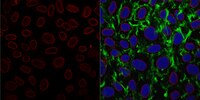MABS1267 Sigma-AldrichAnti-Nuclear Pore Complex Proteins Antibody, clone 414
Anti-Nuclear Pore Complex Proteins Antibody, clone 414 is an antibody against Nuclear Pore Complex Proteins for use in Immunocytochemistry, Immunoprecipitation, Western Blotting, Electron Microscopy.
More>> Anti-Nuclear Pore Complex Proteins Antibody, clone 414 is an antibody against Nuclear Pore Complex Proteins for use in Immunocytochemistry, Immunoprecipitation, Western Blotting, Electron Microscopy. Less<<MSDS (material safety data sheet) or SDS, CoA and CoQ, dossiers, brochures and other available documents.
Recommended Products
概述
| Replacement Information |
|---|
重要规格表
| Species Reactivity | Key Applications | Host | Format | Antibody Type |
|---|---|---|---|---|
| H, Yeast, R, M | ICC, IP, WB, EM | M | Purified | Monoclonal Antibody |
| References |
|---|
| Product Information | |
|---|---|
| Format | Purified |
| Presentation | Purified mouse monoclonal IgG1κ antibody in buffer containing 0.1 M Tris-Glycine (pH 7.4), 150 mM NaCl with 0.05% sodium azide. |
| Quality Level | MQ100 |
| Physicochemical Information |
|---|
| Dimensions |
|---|
| Materials Information |
|---|
| Toxicological Information |
|---|
| Safety Information according to GHS |
|---|
| Safety Information |
|---|
| Storage and Shipping Information | |
|---|---|
| Storage Conditions | Stable for 1 year at 2-8°C from date of receipt. |
| Packaging Information | |
|---|---|
| Material Size | 100 μg |
| Transport Information |
|---|
| Supplemental Information |
|---|
| Specifications |
|---|
| Global Trade Item Number | |
|---|---|
| 产品目录编号 | GTIN |
| MABS1267 | 04055977349740 |
Documentation
Anti-Nuclear Pore Complex Proteins Antibody, clone 414 MSDS
| 职位 |
|---|








